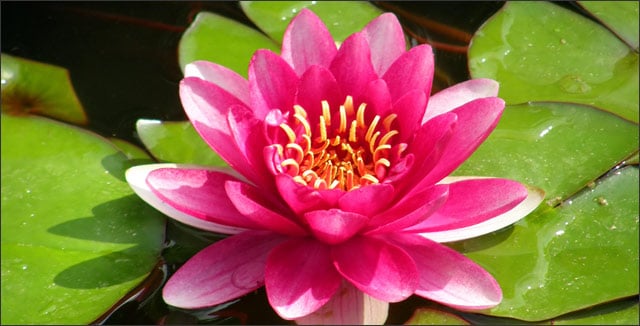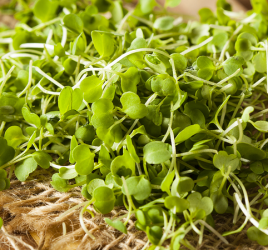
Build a Natural Pool on Your Property and Reap the Benefits

Do you long for a cool getaway on your own property in the warm summer months? But you don’t want the expense and nasty chemicals that go along with owning a pool?
Building an in-ground pool can cost upwards of $50,000 and leave you with a, more or less, permanent concrete hole in your yard that takes up space when it’s not usable.
While it’s fun, it also needs constant maintenance to keep it free of harmful bacteria that could cause you and your guests to get sick. That just means more chlorine and its drying effects on skin and hair.
Consider a Natural Pool
Natural pools, or man made ponds are a fairly common feature in European gardens but many Americans don’t even think of this as an option when deciding whether to put a water feature in their yard. No contractors give this as an option if you ask about building a backyard pool.
This is starting to change, though. More and more homeowners are thinking of this as an option. And here’s why:
It’s cheaper, you can do it yourself and it offers some pretty amazing benefits to your backyard.
Why would this be cheaper?
In ground pools are built like bathtubs – 90 degree angles between the bottom and the sides. And that much water is very heavy. Hence the need for concrete, rebar, fiberglass and the like.
Natural pools are built with gravel, stone, and clay. The rely on aquatic plants to act as a filtration system. The equipment needed for a natural pool is very minimal and relatively inexpensive.
In addition, if you build it yourself – which basically amounts to digging and then planting – you could construct one for as little as $2000. They don’t need to be drained in the fall either. Once you fill the pool, all you may have to do is top it off now and then.
How Can a Natural Pool Possibly Be Clean?
Aquatic plants are amazing. Like all other plants, they enrich the environment with oxygen. They support beneficial bacteria that consume debris and harmful organisms. Additionally, they attract frogs, dragonflies and other beneficial and fascinating water life.
Imagine the possibilities! What if, instead of exposing your kids to a summer of chlorinated water, you could bring more diversity of nature right to your own backyard oasis? Who wouldn’t love to be enchanted by dragonflies while taking a cooling dip in the pool?
Here’s how it works: water passes through the roots of the plants and that good bacteria, which are concentrated on the plants’ roots, act like a filter. They remove contaminants and even excess nutrients.
The other organisms that live on aquatic plants’ roots, decomposer organisms, eat the bacteria. It’s a little closed system, all designed to keep the water clean and free of waste buildup.
This process is different from how chlorinated water works. Chlorine merely kills the bacteria, but it’s all still there, just dead.
How to Get Started With a Natural Pool
To dig a hole that won’t cave in, make sure you keep the ratio of 1 foot vertical drop for every 3 horizontal feet, and reserve 50% of the space in the pool for aquatic plants. You can build a pool up to an acre large and still aerate it using equipment that’s less than $2000.
Once you’ve zoned your pool and figured out if you want plants concentrated at one end or in a ring around the pool, just get digging.
The swimming area should be a bit separated from the plant zone. You can do this in many ways:
- You could keep one part of the pond shallow and plant your plants (but you may end up with more erosion on the other end without any plants).
- Or you can create a rim around the pool of shallow water that would keep plants in place but still allow the water to be filtered. Think of it like a little coral reef around the main swimming part of the pool.
- A maximum depth of 18 inches will be good for some plants, getting more and shallower toward the edges of the pool to house different plants and amphibians that thrive in the warm shallow waters of ponds.
Oh, and by the way: if you’re worried about breeding mosquitoes, put those fears to rest. Go rescue a frog and toad or two and they will not only breed in your pond but all their little offspring will take care of your mosquito problem for you!
Natural Pool Aeration
The other major thing your pool will need is aeration to keep the deeper waters moving through the plant zone. Otherwise, the pool would quickly become stagnant and stinky with anaerobic bacteria.
This is a simple procedure. You need to bury flexible PVC about 18 inches deep and attach it to a ¼ horsepower air compressor with high strength tubing that connects to a diffuser. The diffuser will bubble air through the water and rests in the deepest part of the pool out of reach by swimmers.
The pool will need aeration for 4-8 hours a day, morning and night to replenish the needs of all the organisms depending on it.
Last But Not Least: Plants!

You can do some research to find any construction sites where plants and amphibians are in danger, and ask the company if they’ll let you rescue them and take them to your pool. Otherwise, definitely find out whom to ask for any foraging for water plants in your area.
Protected wetlands are no joke and you don’t want to risk messing up that ecosystem, even for a good cause. If you plan to buy plants, choose the best ones for your climate and wait until the end of the season to build, as you’ll find the best deal on plants at that time.
Here’s a list of great water plants for backyard ponds or natural swimming pools:
For the perimeter:
- Sedge (Carex)
- Rush (Scirpus)
- Lesser cattails (Typha angustifolia)
- Aquatic iris
For the shallowest area:
- Pickerel weed (Pontederia cordata)
- Arrowhead (Sagittaria)
- Water primroses (Ludwigia)
Submerged plants:
- Common waterweed (Elodea)
- Hornwort (Ceratophyllum)
- Water Lillies (Nymphaea)
Floating plants:
- Pondweeds (Potamogeton)
- Duckweed (Lemna minor)
Take Away
Consider building a natural swimming pool this season. One big effort, with some minor upkeep, will ensure your backyard oasis for years to come!



